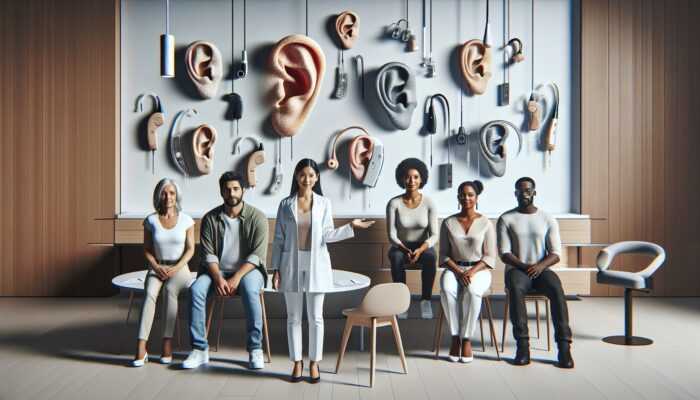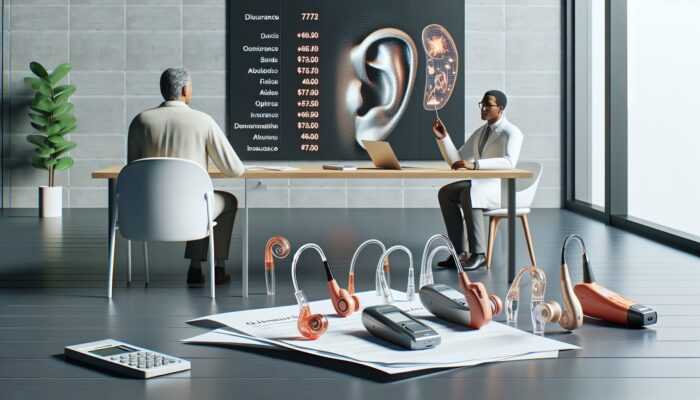Delving into the Intricate Link Between Genetics and Hearing Loss
Understanding the Varied Types of Genetic Hearing Loss
Genetic hearing loss is broadly categorised into two major types: syndromic hearing loss and non-syndromic hearing loss. Syndromic hearing loss occurs in conjunction with other significant medical conditions, showcasing the complex interplay among various genetic factors. Notable syndromes include Usher syndrome, which affects both hearing and vision, and Pendred syndrome, associated with thyroid dysfunction alongside auditory impairment. These syndromic disorders underline the intricate relationship between genetics and hearing loss, often complicating the diagnostic and treatment processes for healthcare providers and patients alike.
Conversely, non-syndromic hearing loss arises independently, specifically due to genetic factors without any additional medical symptoms. This form accounts for roughly 70% of all genetic hearing loss cases and is critical for clinicians to understand as it allows for tailored treatment strategies based on individual patient profiles. Conducting genetic testing can clarify whether an individual’s hearing loss is syndromic or non-syndromic, empowering families with the knowledge needed for informed decision-making regarding healthcare and future family planning.
Numerous genes are implicated in these types of hearing loss, with GJB2 mutations recognised as a leading cause of non-syndromic hearing loss worldwide. This highlights the necessity of understanding each patient’s specific genetic profile. By utilising the advancements in genetic research, healthcare providers can deliver tailored insights and interventions, enhancing overall patient care and outcomes in hearing health management.
Grasping the Inheritance Patterns of Hearing Loss
The inheritance patterns associated with genetic hearing loss carry significant implications for familial relationships and medical decision-making. Commonly observed inheritance patterns include autosomal dominant, autosomal recessive, and X-linked traits. In autosomal dominant inheritance, a single mutated gene copy is sufficient to express the trait, leading to a heightened risk of transmitting hearing loss to future generations. This pattern often leads to quicker identification of the condition within families, enabling proactive management.
In contrast, autosomal recessive inheritance requires two mutated gene copies for the trait to manifest. Individuals with only one mutated copy may remain unaware of their genetic status until hearing loss is detected, often later in life or in their children. This less apparent inheritance pattern can result in underdiagnosis or delays in treatment, complicating the overall management of the condition and its associated challenges.
X-linked inheritance predominantly affects males, who possess only one X chromosome. Males inheriting mutations on their single X chromosome are more likely to experience hearing loss, while females may be carriers without displaying any symptoms. Families with a history of X-linked hearing loss face distinctive challenges during genetic counselling, as the associated risks and implications can substantially differ based on gender, necessitating tailored approaches in genetic education and support.
To summarise, a thorough understanding of these inheritance patterns is vital for anticipating potential outcomes and preparing for future family planning. By raising awareness of these genetic transmission patterns, healthcare professionals can better inform patients and their families about the risks associated with genetics and hearing loss, ultimately leading to more effective management strategies.
Evaluating the Global Prevalence of Genetic Hearing Loss
The global prevalence of genetic hearing loss varies widely across different populations and regions. Approximately 1 in 1,000 infants are born with hearing loss attributable to genetic factors. In certain communities, particularly those with high rates of consanguinity, this prevalence can be significantly heightened. For instance, various studies indicate that in certain Middle Eastern nations, the rate of genetic hearing loss can soar to as high as 1 in 200 live births, primarily due to the increased likelihood of inheriting recessive genetic mutations.
Research indicates that non-syndromic genetic hearing loss is particularly prevalent among East Asian populations, largely due to specific genetic mutations like those found in the GJB2 gene. Conversely, other regions may exhibit a higher prevalence of syndromic forms of hearing loss, underscoring the importance of understanding local genetic backgrounds when assessing risk factors associated with hearing impairment.
Healthcare systems globally are progressively adopting universal newborn hearing screening programmes to detect hearing loss early and promote timely interventions. Such initiatives are especially critical in low-resource settings, where delayed diagnosis can lead to significant educational and social challenges for affected individuals. By raising awareness regarding the frequency of genetic hearing loss, we can encourage efforts to enhance screening programmes, ultimately improving the quality of life for those impacted by auditory impairments.
Investigating Genetic Mutations Associated with Hearing Loss
Recognising Common Genetic Mutations Linked to Hearing Loss
The prevalence of genetic hearing loss is significantly influenced by various genetic mutations. Among the most common mutations are those in the GJB2 gene, which encodes a protein crucial for the proper functioning of auditory hair cells within the inner ear. This mutation accounts for a substantial proportion of autosomal recessive non-syndromic hearing loss worldwide, affecting a wide range of populations.
Another notable mutation occurs in the MYO15A gene, which is vital for the development and functionality of hair cells critical for hearing. Mutations in this gene can lead to severe hearing loss, often detectable at birth or during early childhood. By identifying these prevalent genetic variations, researchers and healthcare providers can focus on targeted genetic testing, facilitating quicker diagnoses and timely interventions.
Furthermore, the SLC26A4 gene is associated with Pendred syndrome and nonsyndromic enlarged vestibular aqueduct, showcasing how certain mutations may result in both hearing loss and additional health complications. This multifaceted role of the gene underscores the complex nature of genetic hearing loss, necessitating comprehensive genetic counselling and testing to grasp fully the implications of these mutations on an individual’s health and well-being.
Gaining insights into these common mutations provides invaluable knowledge regarding the biological mechanisms that underpin hearing loss, paving the way for personalised treatment strategies and improved patient outcomes. As genetic testing and research evolve, there remains a pressing need for continued exploration into rare mutations and their potential implications for auditory health and management.
Comprehending How Mutations Influence Hearing
The effects of genetic mutations on hearing loss can vary significantly, depending on the specific genes involved and the nature of the mutation. Some mutations may lead to mild hearing loss, while others can result in profound deafness. For example, mutations in the GJB2 gene typically present as non-syndromic sensorineural hearing loss, which can range from mild to severe. This variability complicates the clinical landscape, as individuals with identical mutations may experience drastically different auditory outcomes.
Mutations also influence the age of onset, progression, and efficacy of interventions. Early-onset mutations, often identified through newborn screening, open avenues for timely interventions that significantly enhance language development and social integration. Conversely, late-onset mutations may emerge later in life, introducing unexpected challenges and necessitating lifestyle adjustments to accommodate the evolving needs of the individual.
The mechanisms by which genetic mutations affect hearing encompass disruptions in cochlear structural integrity, impairments in hair cell functionality, or interruptions in the pathways that transmit auditory signals to the brain. For instance, defects in the MYO15A gene can impair hair cell function, limiting the ability to accurately process sound signals. Understanding these mechanisms clarifies why specific interventions, such as hearing aids or cochlear implants, may yield better outcomes for certain individuals than for others.
As research progresses, scientists are investigating how specific mutations can inform treatment strategies. Customising interventions according to an individual’s genetic profile holds promise for enhancing therapeutic effectiveness and improving overall quality of life for those affected by genetic hearing loss.
Recent Progress in Mutation Detection Techniques
Recent advancements in mutation detection have significantly transformed the diagnostic landscape for genetic hearing loss. Next-generation sequencing (NGS) technologies enable comprehensive genomic analyses, allowing for the identification of multiple genetic mutations within a single test. This revolutionary advancement is crucial, as traditional methods often focused on a limited number of genes, potentially overlooking critical mutations that could influence treatment pathways.
The adoption of whole exome sequencing (WES) has gained traction, offering a more expansive perspective by capturing all coding regions of the genome. This approach proves particularly beneficial in uncovering rare mutations associated with syndromic hearing loss that may otherwise go undetected. By revealing the full spectrum of genetic alterations, healthcare providers can develop personalised management plans tailored to individual patient needs.
Moreover, the integration of AI and machine learning algorithms into genetic testing protocols is enhancing the speed and accuracy of mutation detection. These advanced technologies analyse extensive datasets, uncovering patterns that human analysts might miss. As a result, genetic testing is becoming more efficient, reducing the turnaround time for results and enabling timely interventions that can significantly impact patient outcomes.
Awareness and education regarding these advancements are paramount. Professionals within the hearing loss community must stay updated on the latest technologies and their implications. This ensures that individuals and families impacted by genetic hearing loss receive optimal care grounded in cutting-edge insights into the genetic factors influencing their condition.
The Essential Role of Genetic Counseling in Hearing Loss Management
Understanding the Importance of Genetic Counseling
Genetic counselling plays a pivotal role in the management of hearing loss, especially when genetic factors are implicated. It serves as a critical bridge between complex genetic information and practical insights for families grappling with hearing issues. Qualified genetic counsellors provide clarity regarding the implications of genetic testing results, assisting families in comprehending their risks and available options moving forward.
Counselling empowers families to make informed decisions about reproductive choices and medical interventions. For instance, understanding the likelihood of transmitting genetic mutations can inform parents’ family planning decisions. This aspect of genetic counselling is particularly impactful in communities where specific genetic disorders are prevalent, as the emotional and social repercussions of hearing loss can be significant.
Furthermore, genetic counsellors provide essential support as patients navigate the emotional complexities associated with a hearing loss diagnosis. This support can alleviate feelings of anxiety and uncertainty, creating a safe environment for individuals and families to voice their concerns, fears, and aspirations. By addressing these emotional needs alongside medical considerations, counsellors can foster resilience and proactive coping strategies among affected families.
In essence, the significance of genetic counselling is immeasurable. As the field of genetics evolves, the demand for robust counselling frameworks to assist individuals and families in understanding and managing genetic hearing loss effectively becomes increasingly critical.
Navigating the Genetic Counseling Process for Families
The genetic counselling process initiates with a comprehensive evaluation of the family’s medical history, focusing on any instances of hearing loss or related conditions. This initial assessment aids counsellors in identifying potential genetic risks that may affect the family. Collecting this information is vital, as it provides context to understand the genetic landscape within the family unit.
Subsequently, genetic counsellors delineate the types of genetic tests available, their purposes, and the potential outcomes. Families often appreciate having a clear understanding of what to expect from genetic testing, including the emotional implications of receiving both positive and negative results. This transparency fosters trust and ensures that families are adequately equipped to navigate the testing process effectively.
Once testing is completed, counsellors play a crucial role in interpreting the results. They assist families in grasping the implications of various genetic findings, discussing the likelihood of hearing loss, associated health conditions, and available interventions. This step is essential, as it transforms abstract genetic information into actionable steps, whether that involves pursuing further medical evaluations, consulting with hearing specialists, or considering assistive technologies tailored to individual needs.
Continuous support is equally critical. Families may have ongoing questions or require additional resources after receiving their results. Genetic counsellors provide sustained support, connecting families to appropriate resources such as community support groups, educational materials, and specialists in hearing loss. This holistic approach ensures that families feel empowered to manage the complexities of genetic hearing loss effectively.
Ethical Considerations in Genetic Counseling for Hearing Loss
The ethical dimensions surrounding genetic counselling for hearing loss are significant and warrant careful consideration. A primary concern revolves around informed consent, ensuring that individuals and families fully comprehend the implications of genetic testing before proceeding. Genetic counsellors must guarantee that patients understand the potential risks and benefits of testing, especially in relation to family planning and future health decisions.
Confidentiality is another ethical cornerstone in genetic counselling. Patients disclose deeply personal information regarding their health and family histories, making the protection of this confidentiality paramount for establishing trust. Genetic counsellors must navigate legal and ethical frameworks to safeguard patient information, particularly in an era where genetic data is increasingly vulnerable to breaches and misuse.
Moreover, the potential for discrimination based on genetic information raises critical ethical concerns. Families may fear that revealing genetic predispositions could lead to stigma or discrimination, particularly in employment or insurance contexts. Counsellors must address these concerns by discussing relevant laws and protections that exist within their regions, reassuring families that privacy safeguards are in place to protect their genetic information.
Finally, the role of genetic counselling extends into the realm of social ethics. Counsellors must be sensitive to cultural beliefs and values that may shape how families perceive hearing loss and genetic testing. A culturally competent approach ensures that counselling respects diverse perspectives, ultimately fostering a more supportive environment for families navigating these challenges.
Understanding the Role of Genetic Testing in Deciphering Hearing Loss
Genetic testing has emerged as an invaluable tool for diagnosing and understanding hearing loss. By analysing an individual’s DNA, healthcare providers can pinpoint specific genetic mutations that may contribute to auditory impairments. Various types of genetic tests are available, each serving distinct purposes within the diagnostic framework.
Targeted mutation analysis focuses on specific genes associated with known hearing loss syndromes. This approach is particularly beneficial when there is a family history of hearing loss or clear clinical indicators. For more comprehensive evaluations, next-generation sequencing (NGS) allows for simultaneous testing of numerous genes, providing a holistic view of the genetic factors involved in hearing loss.
The implications of genetic testing for hearing loss are substantial. Positive results can lead to early interventions, such as cochlear implants or hearing aids, which can markedly enhance language development and social integration. Conversely, negative results may offer reassurance and clarity for families, alleviating concerns about potential hereditary risks that may affect future generations.
However, it is essential to acknowledge the limitations and uncertainties associated with genetic testing. Not all genetic mutations have established correlations with hearing loss, and negative results do not entirely eliminate the possibility of developing hearing issues in the future. Therefore, genetic counselling is crucial for contextualising these findings, assisting families in navigating the complexities inherent in genetic testing and its implications for their health.
As genetic research continues to advance, the potential for improvements in testing methodologies remains promising, offering hope for more accurate, efficient, and accessible diagnostics for hearing loss. While the landscape of genetic testing is likely to evolve, the foundational role of genetic counselling will continue to be a cornerstone for families confronting these challenges.
Comprehensive Strategies for Treatment and Management of Hearing Loss
Examining Current Treatment Options for Hearing Loss
When addressing genetic hearing loss, numerous effective treatment options are available today. Among the most prevalent interventions is the use of hearing aids, which amplify sound and facilitate communication for those affected. These devices can be customised to suit each patient’s unique needs, thereby significantly enhancing the quality of life for individuals experiencing mild to moderate hearing loss.
For individuals suffering from profound hearing loss, cochlear implants offer a revolutionary alternative. These surgically implanted devices bypass damaged hair cells within the cochlea, directly stimulating the auditory nerve. Cochlear implants have transformed many lives, enabling those with severe hearing impairments to perceive sounds and engage more fully with their environment. Research indicates that early implantation can lead to improved language outcomes, highlighting the critical importance of timely intervention in hearing health management.
Moreover, assistive listening devices, such as FM systems, prove advantageous for patients in educational settings or public environments. These technologies enhance sound quality and clarity, allowing individuals with hearing loss to participate more effectively in conversations and classroom discussions. The growing recognition of these technologies underscores the necessity of a multi-faceted approach to managing genetic hearing loss.
Integrating these treatment options into a comprehensive management plan necessitates collaboration among audiologists, speech therapists, and genetic counsellors. By tailoring interventions to each patient’s unique profile, healthcare providers can maximise treatment effectiveness, thereby enhancing communication abilities and overall well-being for those affected by genetic hearing loss.
Exploring Emerging Therapies for Genetic Hearing Loss
Innovation in the treatment of genetic hearing loss is advancing rapidly. Researchers are exploring a variety of emerging therapies aimed at addressing the underlying genetic causes of hearing impairment. One promising area of investigation centres around gene therapy, which aims to repair or replace defective genes responsible for hearing loss.
Recent breakthroughs in gene therapy have demonstrated potential in preclinical models, with early-stage clinical trials already underway. These therapies aim to deliver functional copies of genes directly to the inner ear, potentially reversing the effects of genetic mutations. The excitement surrounding these advancements is palpable, as successful gene therapies could revolutionise the standard of care for individuals facing genetic hearing loss.
Another avenue of research involves the application of stem cell therapy to regenerate damaged hair cells within the cochlea. Scientists are investigating the capacity of stem cells to replace lost or dysfunctional cells, which could potentially restore hearing function. Though still in experimental stages, the implications of these therapies are vast, providing hope for individuals suffering from hearing loss due to genetic factors.
Additionally, advancements in pharmacological treatments are also on the horizon. Researchers are examining medications that target specific pathways involved in hearing loss, aiming to protect auditory cells from damage or promote their regeneration. These emerging therapies could complement existing interventions, creating a multi-faceted approach to managing genetic hearing loss.
As the treatment landscape continues to evolve, it is crucial for healthcare providers to remain informed about emerging therapies. This dynamic field holds the promise for more effective and targeted interventions, ultimately enhancing outcomes for individuals affected by genetic hearing loss.
Implementing Strategies for Managing Hearing Loss in Children
Managing hearing loss in children presents unique challenges and opportunities. Early diagnosis and intervention are crucial for optimising language development and social skills. Newborn screening programmes play an essential role in swiftly identifying hearing loss, enabling timely interventions through hearing aids or cochlear implants.
Upon diagnosing a child with genetic hearing loss, it is vital to develop individualised management plans. Such plans may include speech and language therapy to enhance communication skills and foster social interactions. Engaging trained speech-language pathologists who specialise in hearing loss is essential for providing targeted support as children navigate their communication journey.
Family involvement is equally important in the management process. Educating families about the nature of genetic hearing loss and the available interventions empowers them to advocate effectively for their child’s needs. Support groups can prove invaluable, allowing families to share experiences and strategies for addressing the daily challenges associated with hearing loss.
Educational institutions must also be equipped to support children with hearing loss. Collaborating with schools to implement accommodations such as preferential seating, assistive listening devices, and individualised education plans (IEPs) can facilitate academic success. By fostering an inclusive environment, schools can help children with genetic hearing loss thrive both academically and socially.
Ultimately, the goal is to provide a comprehensive support system that addresses the unique challenges faced by children with genetic hearing loss. By leveraging early intervention strategies, educational support, and family engagement, we can significantly enhance the quality of life for these children and empower them to realise their full potential.
Current Research Endeavours and Future Directions in Hearing Loss
Investigating Current Research Initiatives in Genetics
The field of genetic hearing loss research is rapidly evolving, with numerous studies underway exploring the genetic foundations of auditory impairments. Researchers are examining a wide array of genetic factors linked to both syndromic and non-syndromic hearing loss. This encompasses identifying novel mutations and understanding how these genetic changes influence the structure and function of the auditory system.
International collaborations are becoming increasingly essential, as scientists combine resources and expertise to address the complexities surrounding genetic hearing loss. Large-scale genomic studies, such as genome-wide association studies (GWAS), are elucidating the intricate relationships between various genetic variants and hearing impairment. These collaborative efforts hold the potential to accelerate discoveries and lead to breakthroughs that could reshape our understanding of genetic hearing loss.
Innovative methodologies, including CRISPR-Cas9 gene editing technology, are also being explored within research settings. This powerful tool allows for precise editing of DNA sequences, enabling scientists to investigate the consequences of specific mutations on hearing. By unveiling the mechanisms underlying genetic hearing loss, researchers can pave the way for targeted therapies that address the root causes of auditory impairments.
As research continues to progress, integrating findings into clinical practice will be vital. Translating research discoveries into practical applications can enhance the diagnosis, treatment, and management of genetic hearing loss, ultimately improving outcomes for those affected and their families.
Exploring the Potential of Gene Therapy
The potential for gene therapy to revolutionise the treatment of genetic hearing loss is immense. As researchers identify the specific genetic mutations responsible for various forms of hearing impairment, the feasibility of targeted therapies becomes increasingly realistic. By introducing functional copies of genes directly into the inner ear, gene therapy could restore or enhance auditory functions for individuals with genetic hearing loss.
Recent preclinical studies have yielded promising results, demonstrating that gene therapy can lead to significant improvements in hearing in animal models harbouring genetic mutations. These findings highlight the possibility of translating these therapies into clinical settings, offering hope for individuals facing profound hearing loss due to genetic factors.
Nevertheless, several challenges must be addressed before gene therapy can become a standard treatment option. Ensuring the safety and efficacy of these therapies necessitates extensive clinical trials and rigorous regulatory oversight. Additionally, determining the optimal timing for intervention is crucial; early administration of gene therapy may yield better outcomes compared to late-stage interventions.
The future of gene therapy in hearing loss treatment appears promising, with several ongoing clinical trials investigating various approaches. As scientists refine these techniques and tackle the challenges involved, the dream of restoring hearing through targeted genetic interventions may soon become a reality for countless individuals worldwide.
Fostering Collaborative Research Efforts
Collaborative research initiatives are vital in advancing the field of genetic hearing loss. By fostering partnerships among universities, hospitals, and research institutions, scientists can share resources, expertise, and data to address complex questions related to genetic hearing loss. These collaborations enhance the potential for groundbreaking discoveries that can lead to improved diagnoses and treatments.
International consortia, such as the Global Hearing Loss Consortium, aim to unify researchers across borders to investigate genetic hearing loss. By pooling data from diverse populations, these initiatives can identify genetic variations that may differ regionally and understand their influence on hearing loss. This global perspective is invaluable, as it can yield more comprehensive insights into the genetic factors that impact hearing impairment.
Additionally, collaborative efforts promote the exchange of best practices in genetic counselling and hearing loss management. By sharing knowledge and strategies, healthcare providers can enhance their approaches to supporting patients and families affected by genetic hearing loss. This emphasis on collaboration not only enriches the research landscape but also improves the overall quality of care for individuals facing hearing challenges.
As the field continues to evolve, fostering a culture of collaboration will be crucial in maximising the potential of genetic research. By working together, researchers, clinicians, and families can drive advancements that lead to meaningful improvements in the lives of those affected by genetic hearing loss.
Advancements in Diagnostic Tools for Hearing Loss
Recent breakthroughs in diagnostic tools for genetic hearing loss are reshaping the landscape of auditory health. Techniques such as next-generation sequencing (NGS) and whole exome sequencing (WES) have significantly improved the capacity to identify genetic mutations associated with hearing loss. These sophisticated tools facilitate comprehensive genetic analyses, yielding a clearer understanding of the underlying causes of hearing impairment.
Moreover, the development of multiplex testing panels enables simultaneous analysis of multiple genes linked to hearing loss. This efficiency not only accelerates the diagnostic process but also informs targeted treatment strategies. As genetic testing becomes more accessible and affordable, healthcare providers can seamlessly incorporate these tools into clinical practice, ultimately enhancing patient outcomes.
Additionally, integrating digital technologies into diagnostic processes is expanding the possibilities for early detection of hearing loss. Mobile applications and telemedicine platforms are emerging as valuable tools for facilitating genetic counselling and monitoring. By leveraging technology, healthcare providers can enhance communication and support for families, ensuring they have access to the resources they require for managing their health.
The impact of these advancements on early detection and intervention is monumental. As diagnostic tools become increasingly sophisticated, the potential for timely identification of genetic hearing loss will consistently improve. This, in turn, will lead to more effective management strategies and an enhanced quality of life for individuals affected by genetic hearing loss.
Ethical Considerations in Genetic Research for Hearing Loss
The ethical considerations surrounding genetic research related to hearing loss are intricate and multifaceted. Issues concerning privacy and consent are paramount, as researchers must navigate the ethical implications of collecting and storing genetic data. Ensuring that participants fully comprehend the research’s objectives, potential risks, and their rights is essential for fostering trust and transparency in the research process.
Informed consent is a critical aspect of ethical research practices. Participants must be fully aware of how their genetic information will be utilised and the potential implications of their involvement. This is particularly crucial within the context of genetic research, where findings may hold significant consequences not only for individuals but also for their families and future generations.
Discrimination based on genetic information is another ethical concern. Individuals possessing genetic predispositions to hearing loss may fear potential stigmatization in various aspects of life, including employment and insurance. Researchers must advocate for policies that safeguard individuals from discrimination based on genetic information, ensuring that progress in genetic research does not inadvertently lead to negative societal consequences.
Furthermore, cultural sensitivities and beliefs must be considered in genetic research related to hearing loss. Researchers should strive to engage with diverse communities in a manner that respects their values and perspectives. Culturally competent research practices can help mitigate misunderstandings and foster trust between researchers and participants, ultimately contributing to the success of genetic research initiatives.
As the field of genetic research continues to develop, addressing these ethical considerations will be crucial to ensuring that advancements in our understanding of hearing loss benefit all individuals and communities. Balancing the pursuit of knowledge with respect for individual rights and cultural values is vital for cultivating a responsible and inclusive research environment.
Evaluating the Impact of Hearing Loss on Quality of Life
Examining the Social and Emotional Effects of Hearing Loss
The social and emotional repercussions of genetic hearing loss can be profound and far-reaching. Individuals with hearing loss frequently encounter unique challenges in social interactions, leading to feelings of isolation and frustration. Communication difficulties can hinder relationships, making it arduous to engage in conversations, participate in group activities, or forge connections with peers.
The emotional strain of living with genetic hearing loss may also manifest in various ways. Anxiety and depression are prevalent among those striving to navigate a world that can often feel disconnected. Individuals may struggle with self-esteem issues, particularly when their hearing loss affects their ability to fully participate in social situations. Recognising these emotional effects is crucial for providing comprehensive support to those impacted by hearing loss.
Support systems are vital in addressing the social and emotional needs of individuals with genetic hearing loss. Family, friends, and community support networks foster a sense of belonging and understanding. Participation in support groups specifically tailored for individuals with hearing loss can also provide an avenue for sharing experiences and coping strategies, ultimately alleviating feelings of isolation and disconnection.
Healthcare providers must acknowledge the significance of addressing the emotional aspects of genetic hearing loss. Integrating psychological support into treatment plans can empower individuals to cope with the challenges they face, enhancing their overall quality of life. By cultivating an environment that values emotional well-being, we can assist those affected by genetic hearing loss in leading fulfilling and engaged lives.
Identifying Educational Challenges Related to Hearing Loss
Educational challenges stemming from genetic hearing loss can significantly impact a child’s development and future opportunities. Children with hearing loss may struggle to acquire language skills, participate in classroom discussions, and engage with peers, all of which are essential for academic success. Early intervention is key to mitigating these challenges, underscoring the importance of timely diagnosis and support from healthcare providers.
Schools must be prepared to accommodate the needs of children with genetic hearing loss. This includes implementing individualised education plans (IEPs) that outline specific accommodations, such as preferential seating, the use of assistive listening devices, and additional support from specialised educators. Teachers trained in working with students experiencing hearing loss can significantly contribute to creating an inclusive learning environment that fosters academic success.
Furthermore, raising awareness among educators and peers about genetic hearing loss is paramount. By fostering a culture of understanding and acceptance, schools can help diminish stigma and promote positive interactions among students. Peer support programmes can also encourage social integration and friendship-building, enhancing the overall educational experience for children with hearing loss.
Parental involvement is crucial in advocating for a child’s educational needs. Parents can collaborate with educators to ensure their child receives the necessary support and resources to thrive in the classroom. By working together, families and schools can create an environment in which children with genetic hearing loss can achieve their full potential academically and socially.
Building Support Systems and Resources for Individuals with Hearing Loss
Support systems and resources are essential for individuals and families navigating the complexities of genetic hearing loss. Various organisations and community groups offer information, advocacy, and emotional support, helping families connect with others facing similar challenges. These networks empower individuals to effectively leverage available resources and advocate for their rights and needs.
National and international organisations, such as the Hearing Loss Association of America (HLAA) and the World Health Organization (WHO), provide valuable educational materials, workshops, and conferences aimed at raising awareness and offering assistance for those affected by hearing loss. These resources can aid families in understanding the implications of genetic hearing loss, available treatment options, and coping strategies.
Local support groups also play a significant role in fostering community and connection. These groups offer a platform for individuals and families to share experiences, discuss challenges, and provide mutual support. Whether in person or online, support networks can greatly alleviate feelings of isolation, helping individuals feel heard, understood, and supported.
Healthcare providers should actively engage in connecting patients with these support systems. By providing information about local and national resources, providers can enhance the overall care experience, empowering families to take proactive steps in managing their hearing loss journey effectively.
Ultimately, establishing strong support systems and utilising available resources is crucial for improving the quality of life for those affected by genetic hearing loss. By fostering connections and providing access to information, we can create a more supportive environment for individuals navigating this complex condition.
Assessing Employment and Career Opportunities for Individuals with Hearing Loss
The impact of genetic hearing loss on employment and career advancement can be significant. Individuals with hearing loss often face unique challenges in the workplace, including communication barriers and potential misconceptions about their capabilities. These challenges can impede job opportunities and restrict career progression, necessitating a concerted effort from both individuals and employers.
Employers play a pivotal role in fostering an inclusive work environment. Implementing reasonable accommodations, such as providing assistive listening devices, ensuring accessible communication methods, and cultivating a supportive culture, can empower employees with hearing loss to excel in their roles. Training for managers and colleagues on effective communication strategies can also help dismantle barriers and foster understanding, leading to a more harmonious workplace.
Despite the challenges, individuals with genetic hearing loss can achieve professional success and fulfilment. Many organisations actively seek to promote diversity and inclusion, recognising the valuable perspectives and skills that individuals with hearing loss contribute to the workplace. Networking with organisations focused on disability inclusion can provide invaluable resources and opportunities for career advancement.
Advocacy for workplace accommodations is essential. Individuals with hearing loss should feel empowered to articulate their needs and advocate for themselves in professional settings. By fostering a dialogue about the importance of inclusivity, we can work towards creating workplaces that embrace diversity and offer equitable opportunities for all employees, regardless of their hearing abilities.
Recognising the Importance of Mental Health and Well-being
The effects of genetic hearing loss on mental health and well-being are significant and often overlooked. Individuals with hearing loss may experience feelings of isolation, anxiety, and depression, particularly if they struggle to communicate effectively in social contexts. Addressing these mental health concerns is vital for ensuring overall well-being and enhancing the quality of life for those affected.
Access to mental health support is critical for individuals navigating the challenges of hearing loss. Therapeutic interventions, such as counselling or cognitive-behavioural therapy, can provide valuable coping strategies and emotional support. Mental health professionals with expertise in working with individuals who have hearing loss can help address specific concerns and promote resilience, empowering individuals to manage their emotional health effectively.
In addition to professional support, fostering strong social connections can enhance mental well-being. Support groups and community networks create opportunities for individuals with hearing loss to connect with others who understand their experiences. These connections can alleviate feelings of isolation, fostering a sense of belonging and emotional support.
Moreover, raising awareness about the mental health implications of genetic hearing loss is crucial. By promoting understanding and reducing stigma, we can create a supportive environment that encourages individuals to seek help and prioritise their mental well-being. Ultimately, addressing the mental health needs of individuals with genetic hearing loss is an essential component of holistic care and overall support.
Strategies for Prevention and Raising Awareness
Implementing Effective Strategies for Prevention
Preventing or mitigating the impact of genetic hearing loss necessitates a multi-faceted approach centred on awareness, early detection, and education. One of the most effective strategies involves implementing comprehensive newborn hearing screening programmes. These initiatives facilitate the early identification of hearing loss, enabling prompt intervention that can significantly enhance language and social development for affected infants.
Educating families about the risks associated with genetic hearing loss is equally crucial. Genetic counselling can equip families with the knowledge they need to comprehend their genetic risks and make informed decisions regarding family planning. By raising awareness about genetic testing options and the implications of genetic mutations, families can take proactive measures to address potential hearing loss in future generations.
Community awareness campaigns can significantly contribute to prevention efforts. By educating the public about the signs of hearing loss and the importance of early intervention, we can cultivate a society that prioritises auditory health. Collaborating with healthcare providers, schools, and community organisations can amplify these messages and reach a broader audience, ensuring that more individuals are informed and prepared.
Additionally, promoting healthy auditory habits is vital for preventing acquired hearing loss, particularly among individuals with a genetic predisposition. Encouraging the use of hearing protection in noisy environments and raising awareness about the dangers of exposure to loud sounds can help preserve hearing health for those at risk. By adopting a comprehensive approach to prevention, we can work towards reducing the incidence of genetic hearing loss and enhancing overall auditory health.
Strategies for Raising Public Awareness
Raising public awareness about genetic hearing loss is essential for fostering understanding, acceptance, and support for those affected. Community outreach programmes, educational workshops, and social media campaigns can effectively disseminate information regarding the complexities of genetic hearing loss and the importance of early detection and intervention.
Engaging with advocacy organisations can amplify awareness efforts. Collaborating with groups focused on hearing loss can provide valuable platforms for sharing stories, resources, and information. These organisations often have established networks that can facilitate outreach to diverse communities, ensuring that awareness messages reach those who need them most.
Moreover, integrating hearing loss education into school curricula can promote understanding among younger generations. By educating students about the impact of hearing loss and the value of inclusivity, schools can foster a culture of empathy and support for individuals with hearing impairments.
Additionally, media representation of genetic hearing loss is vital. Highlighting personal stories through documentaries, podcasts, and articles can humanise the experience and encourage dialogue around the topic. By sharing the narratives of individuals living with genetic hearing loss, we can foster a deeper understanding of the challenges they face and the importance of inclusive practices in society.
Ultimately, raising awareness about genetic hearing loss is a shared responsibility. By fostering understanding, advocating for inclusivity, and providing resources, we can create a more supportive environment for individuals and families affected by this condition.
Understanding the Role of Public Health in Hearing Loss
Public health policies are instrumental in addressing the issue of genetic hearing loss. Governments and health organisations must prioritise the implementation of universal newborn hearing screening programmes to ensure early identification and intervention. These screening initiatives are essential for detecting hearing loss in infants, allowing for timely access to treatment and support tailored to their needs.
Additionally, public health campaigns focusing on genetics and hearing loss can educate communities about the significance of genetic counselling and testing. By fostering awareness of the risks associated with genetic hearing loss, these campaigns can empower families to make informed decisions regarding their health and reproductive choices, significantly impacting future generations.
Collaboration between public health agencies, healthcare providers, and advocacy organisations is crucial for developing comprehensive strategies to address genetic hearing loss. By leveraging resources and expertise, stakeholders can create initiatives that promote education, screening, and support for affected individuals and families, ultimately improving their quality of life.
Furthermore, public health policies must prioritise accessibility in healthcare. Ensuring that genetic testing and counselling services are available to all individuals, regardless of socioeconomic status, is vital for reducing disparities in care. By emphasising equal access to resources, we can work towards improving outcomes for individuals facing genetic hearing loss and ensure that everyone has the opportunity to receive appropriate care.
In conclusion, the role of public health in addressing genetic hearing loss is multifaceted. By prioritising prevention, education, and access to care, we can create a comprehensive approach that supports individuals and families navigating this complex condition while enhancing the overall health of communities.
Engaging the Community in Awareness and Prevention Efforts
Community engagement is essential in supporting awareness and prevention initiatives related to genetic hearing loss. Establishing robust partnerships between healthcare providers, advocacy organisations, and community members can enhance awareness and support efforts. Collaborative initiatives empower individuals to take an active role in promoting auditory health and fostering understanding within their communities.
Organising community events focused on hearing health can serve as effective platforms for educating the public about genetic hearing loss and the resources available for support. Workshops, health fairs, and informational sessions provide valuable opportunities for individuals and families to learn about genetic testing, counselling, and early intervention options that can significantly impact outcomes.
Involving individuals with hearing loss in community discussions can amplify their voices and experiences. By sharing personal stories and insights, individuals with genetic hearing loss can help humanise the issue and foster empathy among community members. This engagement also promotes understanding and acceptance, breaking down stereotypes associated with hearing loss and creating a more inclusive society.
Collaboration with local schools and educational institutions can further enhance community engagement. By incorporating hearing health education into school curricula, we can nurture a culture of awareness among younger generations. Encouraging students to participate in advocacy efforts can empower them to become champions for inclusivity and support for individuals with hearing loss, ultimately fostering a more supportive environment.
Ultimately, community engagement is a vital component of promoting awareness and prevention efforts for genetic hearing loss. By working together, we can create a more supportive environment for individuals and families navigating the challenges of genetic hearing loss, ensuring that they receive the understanding, resources, and support they need.
Frequently Asked Questions about Genetic Hearing Loss
What are the primary causes of genetic hearing loss?
The primary causes of genetic hearing loss include mutations in specific genes, which can be classified as syndromic or non-syndromic. Syndromic hearing loss occurs alongside other medical conditions, while non-syndromic hearing loss is isolated to auditory issues without additional symptoms.
How is genetic hearing loss inherited?
Genetic hearing loss can be inherited in various patterns, including autosomal dominant, autosomal recessive, and X-linked inheritance. Each pattern has different implications for the likelihood of passing the condition to offspring and understanding family risks.
What role does genetic counselling play in managing hearing loss?
Genetic counselling assists individuals and families in understanding the implications of genetic testing, assessing risks, and making informed decisions about family planning and treatment options for managing hearing loss effectively.
Are there effective treatments for genetic hearing loss?
Yes, effective treatments for genetic hearing loss include hearing aids, cochlear implants, and assistive listening devices. Emerging therapies, such as gene therapy and stem cell treatments, are also under investigation and show promise for future interventions.
What are common genetic mutations associated with hearing loss?
Common mutations associated with hearing loss include those in the GJB2, MYO15A, and SLC26A4 genes. These mutations can lead to varying degrees of hearing impairment, necessitating tailored approaches to diagnosis and management.
How can families support children with genetic hearing loss?
Families can support children with genetic hearing loss by engaging in early intervention programmes, advocating for educational accommodations, and fostering open communication about their experiences and challenges in navigating hearing loss.
What is the prevalence of genetic hearing loss worldwide?
The prevalence of genetic hearing loss varies globally, with approximately 1 in 1,000 infants being born with it. Rates may be higher in regions with consanguinity or specific genetic backgrounds, emphasising the need for targeted awareness and intervention strategies.
How can communities raise awareness about genetic hearing loss?
Communities can raise awareness by organising educational workshops, collaborating with advocacy organisations, and promoting understanding of genetic hearing loss through social media campaigns and public events aimed at increasing knowledge and support.
What ethical considerations are involved in genetic research related to hearing loss?
Ethical considerations in genetic research include informed consent, privacy protection, and addressing potential discrimination based on genetic information. Researchers must navigate these issues carefully to uphold ethical standards and ensure the responsible use of genetic data.
What resources are available for individuals with genetic hearing loss?
Resources for individuals with genetic hearing loss include support groups, educational materials from organisations like the Hearing Loss Association of America, and access to healthcare providers specialising in auditory health and genetic counselling services.
The post Genetics in Hearing Loss: An In-Depth Exploration appeared first on The Microsuction Ear Wax Removal Network.




















